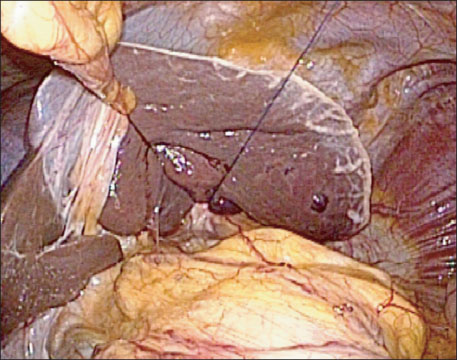J Gastric Cancer.
2010 Sep;10(3):133-136.
V-shaped Liver Retraction during a Laparoscopic Gastrectomy for Gastric Cancer
- Affiliations
-
- 1Department of Surgery, Ajou University, School of Medicine, Suwon, Korea. hansu@ajou.ac.kr
Abstract
- PURPOSE
The aim of this study was to evaluate the effectiveness of our retraction method for achieving a good operative field for the adequate lymph node dissection during laparoscopic gastrectomy in view of short term surgical outcome.
MATERIALS AND METHODS
This study prospectively enrolled 19 patients who underwent laparoscopic gastrectomy for early gastric cancer. The procedure was simply performed by putting the laparoscopic sigle suture in the phrenoesophageal ligament, and then the string was pulling and tying over the sternum. Surgical outcomes of these patients were evaluated.
RESULTS
Under V-shaped liver retraction, the mean operating time and mean number of retrieved lymph nodes was 166.3 minute and 31.37, respectively. And the results were satisfactory compared to open or conventional laparoscopic gastric surgery.
CONCLUSIONS
V-shaped liver retraction requires no extra port or assistant's hands, and prevents additional injury to any intra-abdominal organ. And this method can easily, efficiently and safely enable to achieve a good operative field for the lymph node dissection near the lesser curvature of the stomach.
MeSH Terms
Figure
Reference
-
1. Adachi Y, Kamakura T, Mori M, Maehara Y, Sugimachi K. Role of lymph node dissection and splenectomy in node-positive gastric carcinoma. Surgery. 1994. 116:837–841.2. de Manzoni G, Verlato G, Guglielmi A, Laterza E, Genna M, Cordiano C. Prognostic significance of lymph node dissection in gastric cancer. Br J Surg. 1996. 83:1604–1607.
Article3. Clinical Outcomes of Surgical Therapy Study Group. A comparison of laparoscopically assisted and open colectomy for colon cancer. N Engl J Med. 2004. 350:2050–2059.4. Eltabbakh GH, Shamonki MI, Moody JM, Garafano LL. Laparoscopy as the primary modality for the treatment of women with endometrial carcinoma. Cancer. 2001. 91:378–387.
Article5. Kercher KW, Heniford BT, Matthews BD, Smith TI, Lincourt AE, Hayes DH, et al. Laparoscopic versus open nephrectomy in 210 consecutive patients: outcomes, cost, and changes in practice patterns. Surg Endosc. 2003. 17:1889–1895.
Article6. Kunisaki C, Shimada H, Nomura M, Akiyama H. Appropriate lymph node dissection for early gastric cancer based on lymph node metastases. Surgery. 2001. 129:153–157.
Article7. Hashmonai M, Kopelman D. Sling retraction of the falciform ligament to ameliorate exposure in laparoscopic upper abdominal surgery. Surg Laparosc Endosc. 1996. 6:71–72.8. Sobin LH, Wittekind C, editors. International Union Against Cancer (UICC) TNM classification of malignant tumors. 1997. 5th ed. New York: Wiley-Liss.9. Ryu KW, Lee JH, Choi IJ, Bae JM. Preoperative endoscopic clipping: localizing technique of early gastric cancer. J Surg Oncol. 2003. 82:75–77.
Article10. Roviello F, Marrelli D, Morgagni P, de Manzoni G, Di Leo A, Vindigni C, et al. Survival benefit of extended D2 lymphadenectomy in gastric cancer with involvement of second level lymph nodes: a longitudinal multicenter study. Ann Surg Oncol. 2002. 9:894–900.
Article11. Lee JH, Ryu KW, Doh YW, Bae JS, Kim YW, Bae JM. Liver lift: a simple suture technique for liver retraction during laparoscopic gastric surgery. J Surg Oncol. 2007. 95:83–85.
Article12. Al-Motabagani MAH. An anatomical study of the phrenoesophageal ligament. J Anat Soc India. 2002. 51:18–22.
- Full Text Links
- Actions
-
Cited
- CITED
-
- Close
- Share
- Similar articles
-
- Laparoscopic Surgery for Advanced Gastric Cancer: Current Status and Future Perspectives
- Intracorporeal Anastomosis in Laparoscopic Gastric Cancer Surgery
- Entirely Laparoscopic Gastrectomy and Colectomy for Remnant Gastric Cancer with Gastric Outlet Obstruction and Transverse Colon Invasion
- Laparoscopic Distal Gastrectomy for Gastric Cancer
- Linear-Shaped Gastroduodenostomy in Totally Laparoscopic Distal Gastrectomy



